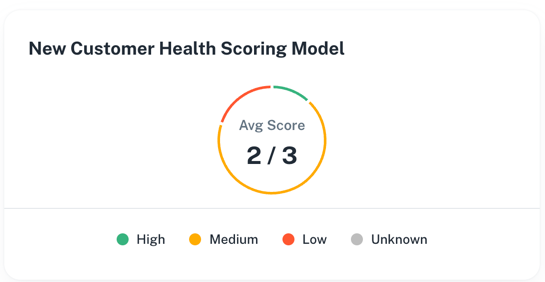Customer Health Score & How to calculate it
 Renat Zubayrov
Renat ZubayrovWhat is a Customer Health Score?
Customer Health Score is an important measure that helps you determine if a customer plans to keep using your product or stop using it. This measure is especially useful for account managers and customer service teams as it gives them an idea of how likely a customer is to stop using the product and how much risk is involved.

Why is Customer Health Score so important?
The customer health score allows you to stay informed about customer relationships. Healthy customers are more likely to remain with your business, while unhealthy customers are at risk of leaving. As soon as you start tracking this metric, you will be able to make data driven decisions and react proactively. As a result you will get the following benefits:
- Reduced churn - satisfied customers are less likely to churn.
- Upsell / Cross-sell opportunities - it’s easier to sell more products and services to happy customers.
- Word-of-mouth - healthy customers are highly likely to promote your product within their network of contacts.
There is no common formula for this type of metric, as exact numbers will depend on your product. However there are some common steps that will guide you through the creation of a best customer health score for you.
- Select your metrics - consider which important indications are relevant to your product. We have prepared some ideas later in this post.
- Establish score distribution - you need to determine the values that indicate if a metric is good or bad. For instance, a WAU / MAU ratio above 0.5 is considered good, while a ratio below 0.3 is considered bad.
- Assign each metric a weight - Consider how a metric affects the overall customer health, as certain metrics may carry more importance than others.
- Segment your customers - your health score model will be simpler if you focus on well-defined customer segments. For example, customers on the 'smaller' pricing plan, by definition, may not have access to particular product features, so measuring product adoption should differentiate by available product features.
- Keep the customer lifecycle in mind - the customer health score indicator may be very subjective to the current customer lifecycle. At each stage of a customer journey like proof of concept, onboarding, training, production usage, and advocacy you should carefully consider what is the success KPIs and leading indicators.
- Try to keep the health score credible and actionable. The fact that the health score is 'red' or 'yellow' should generate management attention, however, it should also be obvious what improvements needed to be made to improve the score.
- Review your health score rules regularly. For example, at the end of each quarter just analyze which customers with a 'green' score churned (false positives) and which customers with a 'red' score renewed / expanded (false negative). Health scoring is not a one-time exercise but a process. Iterating and adjusting regularly will improve your prediction accuracy and understanding of factors influencing customer health.
- Last but not least - automate it! Collecting data and calculating the health score is something you could do with a simple spreadsheet, however, spending CSM's precious time on that is not only economically inefficient but also lead to lower job satisfaction and higher fluctuation. Moreover, you should maintain and update your health score on a regular interval, so spending time in automation and using a dedicated scoring technology will significantly simplify this process and reduce maintenance overhead.
Customer Health Score Examples
Now when you have scored your customers, there are different ways to to represent the results. Here are a few examples.
Percentage Scale
To calculate this, first you need to find the maximum value for the score and divide customer’s score by this maximum value to get a percentage.
Color Code
Assigning colors like e.g. green for healthy customers, yellow for medium healthy and red for unhealthy is a simple but powerful method to visualise the scoring results. It helps customer success managers to quickly understand how well a client is doing.
Alphabetical Scale
Similar to color-coding, an alphabetical scale assigns a letter to each customer based on their customer health score. The higher their score is, the higher the grade.
Customer Health Score Metrics
We have prepared a comprehensive list of blog posts on different useful metrics that might give you some ideas of what you could use to score you customer’s health:
Read more about revenue operations, growth strategies, and metrics in our blog and follow us on LinkedIn, Youtube, and Facebook.
← Go back to blog